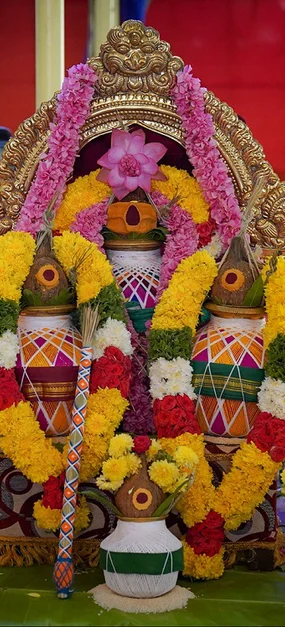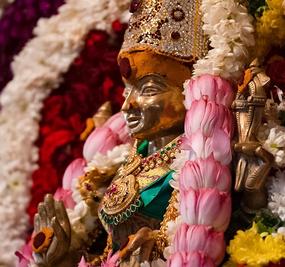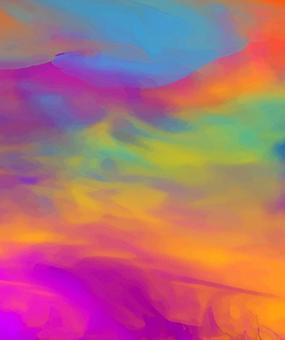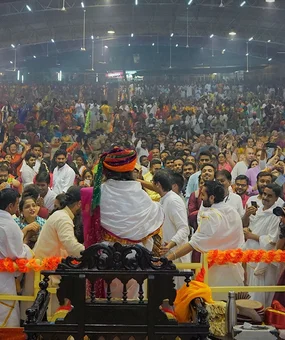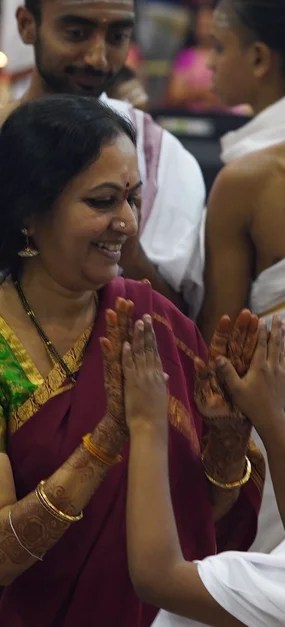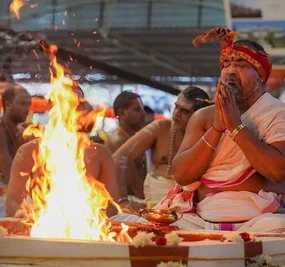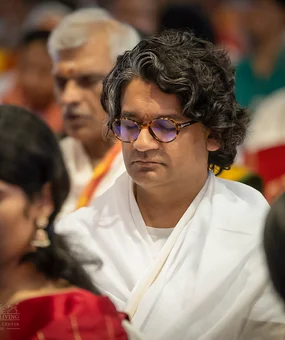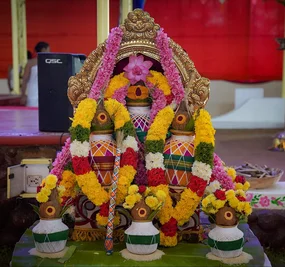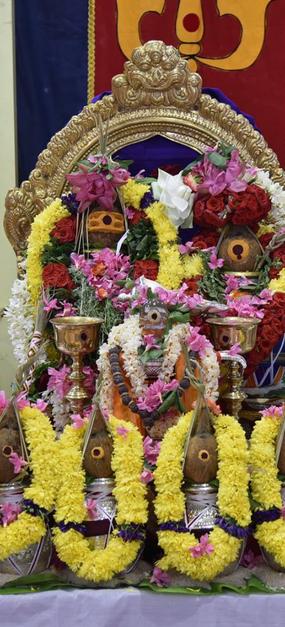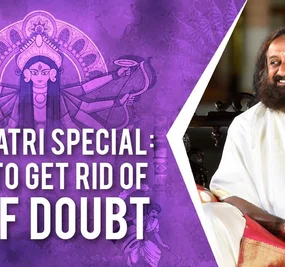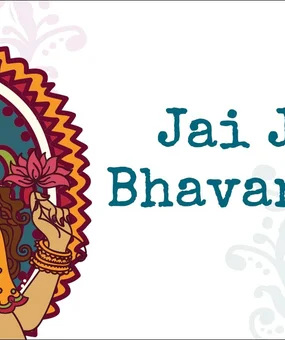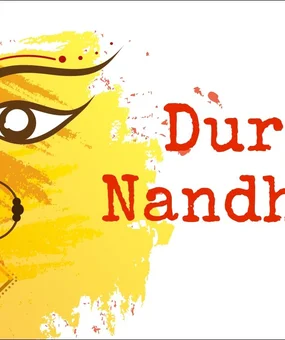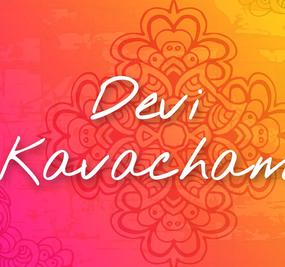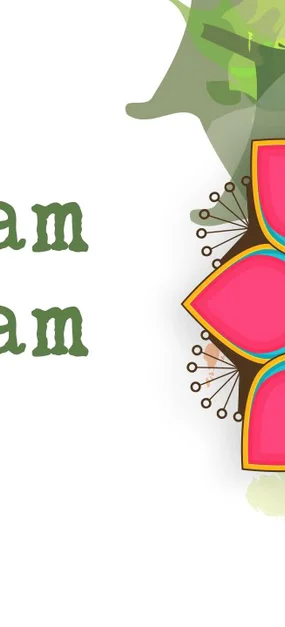Navdurga, All the nine forms of Durga Devi represent nine different qualities. Shakti means energy and Devi Shakti is the primordial source of unseen energy that maintains and sustains this creation. Navratri celebrates and honors the nine different aspects of Mother Divine, also known as Nav Durga.
The Devi Shakti, or the feminine spirit, manifests itself in many forms. It encompasses and supplements qualities such as strength, transformation, anger, beauty, compassion, fear, and power. These qualities are reflected in each individual, in different events, and in this universe as a whole.
Shailaputri
The first name of Goddess Durga is Shailaputri. Shaila means the peak.
Why is Goddess Durga called as the daughter of the peak?
The Reason behind Goddess Durga being called daughter of the peak as per scriptures
We usually think this means that the Goddess is the daughter of Mount Kailasa, but this is a very basic or lower level of understanding. On the path of Yoga, this means the highest peak or the highest level of consciousness.
This is very interesting – when the energy is at its peak, only then can you notice and recognize it. Only then can you understand and experience the pure consciousness – the Devi. Before it reaches its peak you cannot understand it, because it is born out of the peak.
Here the peak is the peak of any experience, or any intense feeling. If you are 100% angry, then just see how that anger consumes your whole body. Often we do not express our anger fully. Just see, when you are 100% in anger, when you become that anger so fully, you will also come out of it very soon. When you are 100% in anything that consumes your whole being, that is when Goddess Durga is really born. When you are totally 100% consumed in anger, then you will experience such a surge of energy and at the same time you will instantly find yourself coming out of that anger also.
Have you seen how children behave? Whatever they do, they do it 100%. If they are angry, they are angry 100% in that moment and then immediately they also drop that anger after just a few minutes. They do not get tired even if they get angry. But as an adult if you get angry, then it tires you. Why is it so? It is because you do not express your anger 100%. Now, this does not mean that you go around being angry all the time. Then you will also have to face the trouble that anger brings along.
When you reach the peak of any experience or feeling, you experience the emergence of the Divine consciousness, because it always surges from that peak. This is the hidden meaning behind Shailaputri.
Brahmacharini
The second name of the Mother Divine is Brahmacharini.
What does Brahman mean?
That which has no end, no shore nor beginning; That which is omnipresent and beyond which there is nothing; It is the ultimate and all-pervading.
If you close your eyes and meditate, then you will realize that when your energy rises to the peak, it becomes one with the Mother Divine; it gets soaked in the energy of the Mother Divine. The Divine is within you, and not somewhere outside.
You cannot say, “I know it”, because it is infinite. The moment you know it, it becomes finite. Nor can you say “I do not know it”, because it is definitely there. How can you not know? Can you say “I do not know my own hand”? Your hand is right there. It is there hence you know It, and It is infinite so you do not know It. Both of these realizations go hand in hand. Are you confused enough?
If someone asks you, “Do you know the Mother Divine”, you can only keep quiet, because if you say, “I do not know”, then that is not true, and if I say, “I know”, then you are limiting that ‘knowing’ through words and the limited intellect. It is infinity, and Infinity cannot be comprehended or contained.
“Knowing” means containing or restricting something. Can you contain infinity? If you contain infinity then it is no longer infinity. Brahmacharini means one who is present and moves in the infinity. She is energy that is not stagnant or inert, but moving in infinity.
This is a very important thing to understand – one is movement and the other is presence. This is what Brahmacharya means. Brahmacharya means not indulging in small things, not getting stuck in small limited things but indulging in the whole. Celibacy is also said to be synonymous with Brahmacharya because in that you are dealing with the greater whole and not with limited parts. Lust is always in parts, it is the localized movement of consciousness. So, Brahmacharini is the consciousness that is all-pervading.
Chandraghanta
The third form of the Mother Divine is Chandraghanta.
What does the word Chandraghanta mean?
Chandra (Moon) means the mind. The mind keeps having its ups and downs. Usually, we fight with our own mind. Negative thoughts such as jealousy, hatred, etc. come in the mind and one starts struggling to get rid of them, but it does not happen. You cannot get rid of your mind. Running away from your mind does not help. The mind is like your shadow.
We become dejected and restless the moment our mind is gripped by any negative feeling. We try to wash away all these things from our mind by doing various techniques, but it works only for a short time. After a while, the mind comes back to square one! Do not struggle to get rid of that.
Chandra also signifies the various feelings or shades of emotions and thoughts (similar to the different phases of the waxing and waning moon).
Ghanta means a bell from which only one kind of sound arises. Do you ever hear multiple sounds from a bell? No matter how you play it, only one kind of sound comes from the bell. In the same way, when the mind that is scattered and entangled in different thoughts and emotions gets consolidated and established at one point (in the Divine), then it gives rise to the Divine energy within us which becomes one-pointed and rises upwards. This is what is meant by Chandraghanta. Her name literally means (The bell of the moon).
It means that state where the scattered mind becomes steady and consolidated towards one thing only. Do not run away from the mind, for the mind is also a form and manifestation of the Mother Divine. The Mother Divine is present even as sorrow, misery, hunger, and peace as well. The essence here is to take everything together – whether harmonious or unpleasant – as a collective whole, bringing all thoughts, emotions and sounds as one Naad (sound) like the sound a bell or a large gong makes. This is the meaning behind the Devi’s name Chandraghanta, and the third day of Navratri is celebrated to honour this form of the Mother Divine.
Kushmanda
The fourth form of the Mother Divine is called Kushmanda. Kushmanda is also the Sanskrit word for ‘pumpkin’. Now, if you even jokingly call someone a ‘pumpkin’, they will feel insulted and charge at you!

What does the word Kushmanda really mean?
A pumpkin is round. So here, it refers to your Prana (subtle life force energy) and that too, Prana which is total; complete like a sphere.
It used to be a traditional custom in India that the pumpkin was eaten only by Brahmins, the intellectuals. No one else in society used to eat pumpkin. A pumpkin is supposed to enhance one’s Prana, one’s intelligence and energy. A pumpkin is said to have the unique property of absorbing Prana and also radiating Prana. It is one of the most pranic vegetables on the planet. Just like the leaves of the Ashwath tree generate oxygen 24 hours through the day, in the same way, the pumpkin absorbs and also radiates energy.
This entire creation – both the manifest and the unmanifest – is like a huge round ball or pumpkin. You have all kinds of diversity here, from the smallest to the largest.
“Anda” here means the Cosmic Egg or the Cosmic Sphere. “Ku” means small, “sh” means Energy. So energy pervades this entire Universe from the smallest to the largest. From small it becomes big and from big it becomes small. From the small seed it becomes a huge fruit, and from the huge fruit it comes back into seed.
Our energy has this unique quality of being smaller than the smallest, and larger than the largest. This is explained by Kushmanda and this is why the Mother Divine is also called Kushmanda. It means that the Mother Divine manifests as the Prana, as the energy within us.
Just sit and think of yourself as a pumpkin for just five seconds or so. The meaning here is to elevate yourself to the Supreme Intelligence which is the Mother Divine Herself. Like a pumpkin, you too should feel the abundance and fullness in your life, and see everything in creation as so alive with Prana in every particle. Seeing that awakened intelligence manifest and pervading everywhere in creation is the meaning of Kushmanda.
Skandamata
The Mother of Wisdom: Skandamata
The fifth form of the Mother Divine is Skandamata.
Skanda is another name for Lord Karthikeya who represents the coming together of Jnana Shakti (power of knowledge) and Kriya Shakti (power of righteous action). Skanda is the combination of these two. Skandamata is that form of the Divinity that brings practical wisdom and action together.
The Shiva Tattva is the blissful principle, ever calm and disengaged from action. The Devi Tattva (Mother Divine) is the primordial energy responsible for action and activity in creation.
It is said that the Devi represents the confluence of Iccha Shakti (power of intention), Jnana Shakti (power of knowledge) and Kriya Shakti (power of righteous action). When the Shiva Tattva unites with these three powers, then what emerges is Skanda.
Skandamata represents the very origin of Jnana (knowledge) and Kriya (the principle of action or activity). It can be understood as Kriyatmak Jnana (knowledge in action or action driven by right knowledge).
Many times, we see that knowledge is there but it has no purpose, or it cannot be used in any action as such. But there is also knowledge which has a definite end or purpose (attained through action). In college, you study subjects like Physics and Chemistry in great detail, but you do not use it much in your daily life. When you study Medicine, then you use that knowledge every day. When you understand how to repair a television, then you can use that knowledge and skill to repair a TV when it is damaged. Or like when you learn how a motor works and how to repair it. This is more practical-oriented knowledge. Skanda signifies the coming together of knowledge and (righteous) action in our life. Skanda Tattva is thus an extension of the Devi Tattva (Mother Divine).
We often say that the Brahman is manifest everywhere and is omnipresent; but at present when you have a difficult situation to deal with in your life, then what do you do? What knowledge would you use then? In order to resolve the problem you need to act, you need to put knowledge into action. So when you take action that is guided by knowledge, it is the Skanda Tattva that manifests. And Goddess Durga is considered as the mother of the Skanda Tattva.
Kathyayini
The sixth form of the Mother Divine is Katyayani.
Everything that happens and unfolds before us, which is called Prapancha is not limited only to what is visible. That which is invisible and cannot be perceived by the senses is far greater than we can even imagine and comprehend.
The subtle world which is invisible and unmanifest is ruled by this form of the Mother Divine – Katyayani. In this form, she represents everything that cannot be seen or understood. Katyayani represents the deep and most intricate secrets of Divinity.
How did this form of the Mother Divine come to manifest? The Story behind the manifestation of Mother Divine to the form of Kathyayani
Once upon a time it so happened that all the demigods became very angry. The form of the Mother Divine that arose from this anger came to be known as Katyayani. There are divine and demonic forces in creation. So also, anger can be a positive or a negative force.
How can anger be a positive or a divine quality, and when can it become a negative or a demonic quality? There is a huge difference between the two. Do not think that anger is only a bad quality. Anger is also important and has its own place. Good anger is associated with wisdom, while bad anger with emotions and selfishness. Good anger comes from a sense of broad vision. Anger is appropriate when it is directed towards injustice and ignorance. Usually whoever gets angry tends to think that his anger is justified and directed towards some injustice only! But if you go deeper into more subtle levels of existence, you will find that it is not really so. In such cases, anger actually creates bondage for the person. So, the anger that arises for righteous reasons and is directed towards negativity and injustice is represented by Devi Katyayani.
You must have witnessed so many natural calamities which people call the revenge of Nature. For example, many places get struck by huge earthquakes, or severe floods. All these happenings are attributed to Devi Katyayani. Devi Katyayani represents that divine principle and form of the Mother Divine which is behind such terrible natural calamities and disasters. Devi Katyayani also represents that anger that arises in Creation to restore and revive the principles of Dharma and truth. Katyayani is the divine force or principle of the unmanifest Divinity that arises in the subtle layers of creation against negativity and for the purpose of restoring Dharma. It is said that the anger of a wise person only brings about greater good; whereas even the love of an ignorant or foolish person can only cause more trouble. That is why Devi Katyayani actually represents a beneficial and uplifting force.
Kaalaratri
The seventh form of the Mother Divine is said to be Kaalratri.
It is a very fierce and terrifying form of the Mother Divine. There can be no form more terrifying than this in the entire Creation but even this terrifying form has a motherly aspect to it.
The Kaalratri form of the Mother Divine is said to bestow Jnana (knowledge) and Vairagya (dispassion).
Maha Gauri
The epitome of beauty: Mahagauri
The eighth form of the Mother Divine is called Mahagauri.
Mahagauri means that form which is beautiful and resplendent. If you see, Nature has two extremes. One of the forms is Kaalratri which is most terrifying and devastating, and on the other hand you see Mahagauri which is the most beautiful and serene form of the Mother Divine.
Mahagauri represents the epitome of beauty. Mahagauri confers and fulfills all your wishes and desires. Devi Mahagauri gives you all blessings and boons that you seek for material gains, so that you become content from within and move forward in life.
Siddhidhatri
The ninth form is called Siddhidhatri.
Siddhidhatri form of the Mother Divine blesses you with Siddhis (extraordinary capabilities) so that you do everything with perfection. What does Siddhi mean? Siddhi means that you get what you need even before the desire for it arises. You need not even work or act to attain something. At the mere thought of it you are able to attain what you desire, without having to struggle or make efforts for it. This is what is meant by Siddhi.
Whatever you say becomes the truth and manifests, and is for the benefit of everyone around. Whatever work you take up gets completed to perfection. This is Siddhi. Siddhi brings fulfillment and totality in every sphere of life. This is the significance of Devi Siddhidhatri.



